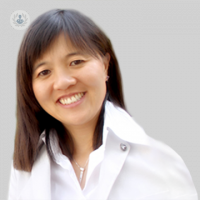How to fix teeth misalignment with braces
Written in association with:Braces are used to correct crooked teeth by moving the misaligned teeth into a healthy position, which ultimately leads to a beautiful, healthy smile. But what causes teeth misalignment in the first place and is it even possible to visit a specialist during the COVID-19 era right now? We were fortunate to speak to one of our highly-experienced orthodontics Dr Moira Wong at her clinic in London, where she answered these questions and more.

What causes teeth misalignment?
Teeth misalignment can be caused by a combination of genetic factors (the genes that we inherit from our parents) and environmental factors, which are things that we do. This may involve thumb or finger sucking, habits such as pushing the tongue forward, biting the lip or sucking on a dummy. Over a number of hours per day with these habits, the teeth can become crooked.
Do braces improve anything else apart from the appearance of a smile?
The reason for braces is to improve functionality. What we are looking to do is for the teeth to come together so the biting forces are evenly distributed across all of the teeth, including the front and back. We don’t want to put an excess load on either side and by distributing the forces evenly, individual teeth don’t suffer and the load is shared.
When anything is healthy, for example, your hair, it looks beautiful. When teeth are healthy and in a healthy position, they too look beautiful. The aim is to put the teeth in a good position and the fact that they look aesthetically-pleasing as a result of this is a side effect.
Is it possible to fix crooked teeth without traditional braces?
There are many different types of braces on the market. Essentially the science behind it is, if you put light force on the tooth, whether you use traditional or removable braces for the first six hours nothing happens.
It’s only after six hours of continuous force that we see a change in the bone, which shows us that the tooth is starting to move. Traditional braces are fixed and go on the outside of the teeth with a very effective, continuous force. You can get braces that sit on the inside of the teeth, which are invisible. The popular Invisalign style of appliances has to be worn up to 24 hours. This is the same with removable ones for younger children.
What foods shouldn’t I eat if I have braces?
Generally, whatever brace you are wearing you want to limit high-sugar foods and even without braces, these types of foods are harmful to your teeth. Sugar is more likely to linger on teeth for a long period if you’re wearing equipment. In terms of fixed braces, whether they are on the inside or outside of your teeth, avoid very hard or sticky things as, for example, biting a raw carrot with front teeth is a lot of pressure on the appliances. They are more likely to break and come away. Other culprits include chewing gum and toffees.
What should I do if my the wires or bands on the braces come loose?
This will depend on the individual case. I normally ask patients to send a photo via WhatsApp or email to the clinic and we can assess how urgent it is to replace them. In some cases, it depends on the position of the band or bracket coming away and their tooth position. Sometimes it makes no difference to sort it out there and then or wait until their next appointment but we advise accordingly. It’s critical not to delay treatment for some patients.
What are the current guidelines on visiting the orthodontist at the moment?
We are working on a backlog and we are catching up with treatments. We have a lot of new patients and we have children who have been waiting for a long time for braces. My team and I are working longer hours to offer more appointments.
Orthodontistry is different to dentistry because we don’t generate aerosols and therefore we don’t have the same level of risk that dentistry carries. At the moment, we can operate and we are wearing the highest level of PPE as if we are generating aerosols.
There is a low risk of infection in our clinic as we disinfect in-between every patient, which is the norm for us. The only changes we have is that we are asking screening questions before the appointment and on the day of the appointment, we are taking temperatures. We clean the waiting room area between all of the patients. You may find that you have to wait a little bit longer but we are taking all of the necessary precautions.
An important message for all patients is that if they are ready to have braces it’s easy to have it done at the moment. They do not need to feel worried and more importantly, they should not delay treatment. Of course, we are more than happy to answer any queries or concerns that you have should you choose our clinic and a member of our team will put your mind at rest.
If you would like to discuss your braces option, then you can send make an appointment with Dr Wong via her Top Doctor’s profile here.


